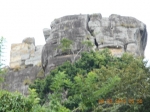Causes Of Cubic Rocks And Precipitous Rock-walls Of Sri Lanka
Abstract Category: Science
Course / Degree: Master of science
Institution / University: Private research, Sri Lanka
Published in: 2016
©The Causes of Cubic Rocks and Precipitous Rock-walls of Sri Lanka
Author: Hamsen B Paramahamsa
Sri Lankan Rocks are cubic and have precipitous cuts that at many places are just vertical. The three good examples are Sigiriya, Uthuwankandha, Bathalagala called also as Bible Rock. Complementary to it are the Rock-walls of Ravannah’s-cut at Trinco. They, the walls, standing erect as if to protect the whole island from any kind of hazard, are nice to see from the ocean. Going vertically up tens of metres, and going deep into the water the same way.
Three from many Cubic Rocks see attachments
Pic 1 Sigiriya Pic 2 Uthuwankandha Pic 3 Bathalagala (Bible Rock)
The Vertical Rock-walls of Trinco and the cuts see Attachments
Pic 4 Ravannah’s Cut. Pic 5 A Cut seen from the ocean pic 6 A mess of Earth movements
The causes for such morphology, whether cubic-rocks or precipitous walls lie in the Ballerina Effect in the earth’s crust. The Earth is a spheroid with the bulge at the equator. The bulge comes from Ballerina Effect such that when she spins she can regulate the speed with the position of the arms and limbs. When she stretches out, the spin slows and rises when the limbs are brought to the body. It is nothing but the law of conservation of momentum.
Every molecule bears its own momentum. The momentum depends from the position of the molecule from the centre, the radius. Such that the molecule at the top most point on the head of Ballerina, through which the axis of rotation runs, has just no speed. For the last molecule at top turns on the axis. It will have speed only when it is not in line with the axis. All the other molecules have a speed. It varies from the distance to the axis. The extreme end of the limb has the maximum.
With the earth it is the same. The earth’s rotational momentum has an effect on it. The angular momentum brings a speed depending on the radius. At the poles it is the least tending to be zero at the top of the poles. The last mass or molecule, if its centre is in line with the axis, it just turns one round where as others speed round. However, if the lasts mass’s gravitational centre is not in line with the axis then it gets a minimal momentum.
The earth has perpetual force of gravity. It is maximum at the poles. The top most point has no centrifugal force, for it just turns few metres a day at the axis while others speed around thousands of kilometres. As they speed around they stretch outwards. But the gravitational force holds them from escaping. The speed increases where the freedom to stretch is maximum. That is at the gravitational mid-point between the poles. And the run still held by gravity, pulls the poles towards one another.
The controlling forces are gravity which becomes inward pulling centripetal and energy from the momentum brings about outward pulling centrifugal force. Since the poles cannot stretch out to balance the momentum others stretch and have the maximum at the equator.
The earth’s surface is not permanently fixed. There are many forces at work. The angular momentum varies in minute amounts daily, too. To that comes the weathering of the rocks and erosion of the soil from higher position to lower. Plus the activities of human infrastructure, removal of trees and others that reduce the mass of the mountains. The result is the Ballerina Effect comes to action. What is brought down is compensated from the rise from the depths.
When the rocks rise up from the depths they come from a lesser radius region to higher radius region. Correspondingly the circumference increases. It has an eventuality that the area of the surface increases, too. With it the volume of the section. Since the rising layer cannot increase its volume, it breaks into different volumes of blocks like a bulging cake in a bakery. In homogenous rocks the resulting forms are cubical, huge and small Rocks and frighteningly precipitous walls that run deep.
Pic 7 piece of a block at Sigiriya Pic 8 Minor blocks at Sigiriya see attachments
If the rising layer-mass has different densities at different sections the rise will get subjected to horizontal vectors, too. For the higher density travels towards the higher speed, to the equator, while the low density rocks move towards the poles. This produces confusion like in pic. 6
Thesis Keywords/Search Tags:
Balerina Effect, Soil erosion, mountain forming
This Thesis Abstract may be cited as follows:
No user preference. Please use the standard reference methodology.
| Thesis Images: | |

|
Sigiriya Rock (click to enlarge) |

|
Uthuwankandha (click to enlarge) |

|
bible rock (click to enlarge) |
Submission Details: Thesis Abstract submitted by Balasupramaniam Paramahamsa from Sri Lanka on 03-Apr-2016 10:05.
Abstract has been viewed 2086 times (since 7 Mar 2010).
Balasupramaniam Paramahamsa Contact Details: Email: eecoltd2@gmail.com
Disclaimer
Great care has been taken to ensure that this information is correct, however ThesisAbstracts.com cannot accept responsibility for the contents of this Thesis abstract titled "Causes Of Cubic Rocks And Precipitous Rock-walls Of Sri Lanka". This abstract has been submitted by Balasupramaniam Paramahamsa on 03-Apr-2016 10:05. You may report a problem using the contact form.
© Copyright 2003 - 2025 of ThesisAbstracts.com and respective owners.